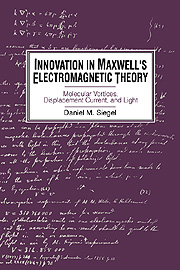Book contents
- Frontmatter
- Contents
- Preface
- Introduction
- 1 The background to Maxwell's electromagnetic theory
- 2 Mechanical image and reality in Maxwell's electromagnetic theory
- 3 The elaboration of the molecular-vortex model
- 4 The introduction of the displacement current
- 5 The origin of the electromagnetic theory of light
- 6 Beyond molecular vortices
- Conclusion
- Appendix 1 Draft of “On Physical Lines of Force,” a fragment
- Appendix 2 Drafts of “A Dynamical Theory of the Electromagnetic Field”
- Appendix 3 Vortex rotations in a curl-free region
- Notes
- Index
Conclusion
Published online by Cambridge University Press: 24 October 2009
- Frontmatter
- Contents
- Preface
- Introduction
- 1 The background to Maxwell's electromagnetic theory
- 2 Mechanical image and reality in Maxwell's electromagnetic theory
- 3 The elaboration of the molecular-vortex model
- 4 The introduction of the displacement current
- 5 The origin of the electromagnetic theory of light
- 6 Beyond molecular vortices
- Conclusion
- Appendix 1 Draft of “On Physical Lines of Force,” a fragment
- Appendix 2 Drafts of “A Dynamical Theory of the Electromagnetic Field”
- Appendix 3 Vortex rotations in a curl-free region
- Notes
- Index
Summary
Three perennial issues in Maxwell scholarship have woven their way through our study of the origins of the displacement current and the electromagnetic theory of light in the context of the molecular-vortex model: The first concerns the relationship between Maxwell's accomplishments and the mechanical worldview, the second addresses the role of the field-primacy approach in the genesis of Maxwell's innovations, and the third concerns the unity and coherence of Maxwell's mechanical models and mathematical formalisms.
Maxwell and the mechanical worldview
We have seen that Maxwell's stance with respect to mechanical models and his use of them was conditioned by the confluence, in his educational background and scientific training, of Scottish (Edinburgh) and Cambridge traditions, with the former inclining toward an analogical interpretation of mechanical representations, and the latter toward a more ontologically committed approach, in which mechanical hypotheses were viewed as candidates for reality, and evidence of a hypothetico-deductive character was accepted as providing support for their realistic status.
We have examined the movement of Maxwell's own ideas and practices concerning mechanical modeling: from an initial reliance on mechanical models as heuristic physical analogies – in the Scottish, skeptical vein – thence to the installation of the molecular-vortex model as the basis for a realistically intended physical theory – as countenanced in Cambridge methodology – and finally to an attenuated mechanism – representing Maxwell's own, carefully balanced position - in which the physical universe continued to be viewed as ultimately mechanical, but the possibility of coming to know the details of the mechanism receded indefinitely.
- Type
- Chapter
- Information
- Innovation in Maxwell's Electromagnetic TheoryMolecular Vortices, Displacement Current, and Light, pp. 168 - 173Publisher: Cambridge University PressPrint publication year: 1992



